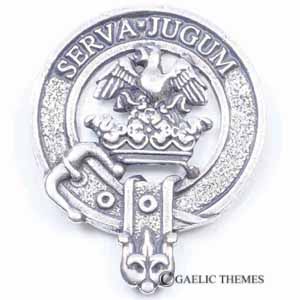Hay
Select
- Clan Motto: Serva jugum (Keep the Yoke)
- Notes:
Crest: Issuing out of a Crest Coronet a falcon volant Proper, armed, jessed and belled
The Hays are descended from the powerful de La Haye princes of Normandy who followed William the Conqueror. The lands of Errol in Perthshire were given to one William de Haya by charter in 1172.
The family's rise was cemented when Sir Gilbert Hay became a right-hand man to Robert the Bruce, fighting in many campaigns with the king.
Gilbert was awarded the lands of Slains in Aberdeenshire and maned Lord High Constable of Scotland in 1309. In 1314 the title was made hereditary and is still held by Clan hay today. The job entailed guarding the personal safety of the monarch and prosecuting anyone indicted for riot or crimes of bloodshed near the royal person.
The Hays possess some royal blood. The seventh baron of Errol, Sir Thomas, married Elizabeth, daughter of Richard II. David de la Hay married Ethna daughter of the earl of Strathearn, thus bringing in ancient Celtic royal lineage.
A true knight errant, Sir Gilbert Hay fought for the cause of Joan of Arc and attended the coronation of Charles VII of France. His descendants are the Hays of Delgatie -- their castle at Turriff is the Clan Centre.
Sir William Hay of Delgatie served as chief of staff for Montrose when he fought for Charles I. When the Royalists were defeated, Hay was imprisoned and later executed in 1650. After the Restoration, Delgatie was accorded a state funeral and is buried in St. Giles’ in Edinburgh.
In 1594, the lord Argyll led a campaign against the Protestant nobles of Scotland. The Hays, as well as the Gordons and Red Douglases, were in alliance. When the revolt failed, James VI declared them rebels. Slains Castle was blown up, never to be rebuilt. Erroll later converted to Protestantism and was able to return to Scotland, and to royal favor.
Loyal to the Stuarts, the Hays took part in both the 1715 and 1745 uprisings. James VIII, ‘the Old Pretender’, granted the thirteenth earl Hay the Order of the Thistle.
Hay’s sister, Mary, succeeded him and used the ruins of Slain castle as a secret rendezvous spot for Jacobite agents. It was she who called out the clan for Bonnie Prince Charlie.
The eighteenth Earl served as Lord High Constable during George IV’s visit to Edinburgh in 1822. He spent a fortune on the event and was nearly bankrupt. The nineteenth Earl, William Hay, was wounded at the battle of Alma in the Crimea, 1854. William was very concerned for his people. He founded the fishing village of Port Erroll which offered good, low-rent housing to fishermen. He also provided well for the widows and orphans of fishermen’s families.
William’s son was the twentieth Earl, Major General Charles Hay. Charles saw action in the Boer War, commanded the Household cavalry and was lord-in-waiting to Edward VII.
In 1950, Diana, Countess of Erroll, founded the Clan Hay Society, which now has branches across the globe.
The great Adam mansion of Yester near Gifford in East Lothian is the home of the Hays of Yester, Marquesses of Tweeddale.
